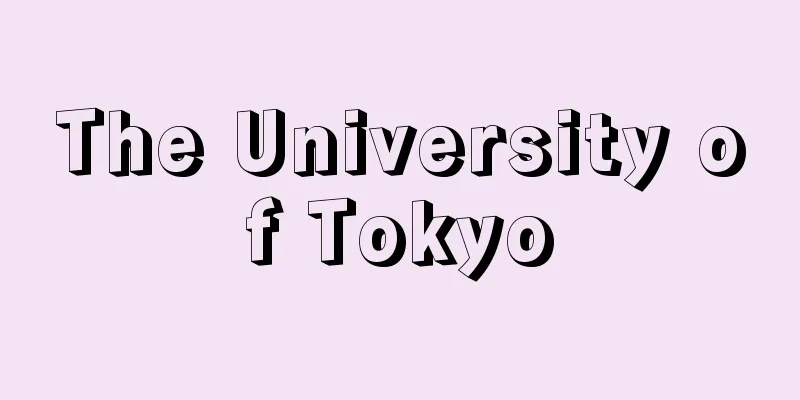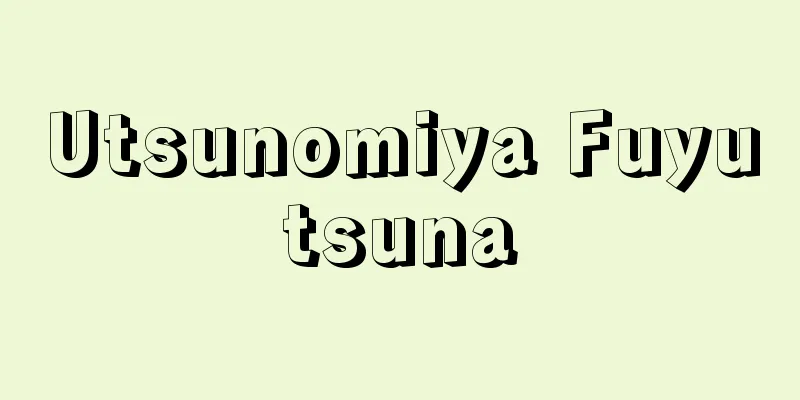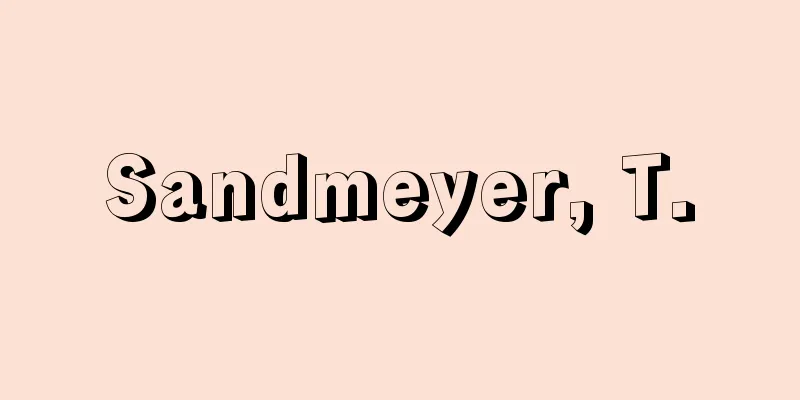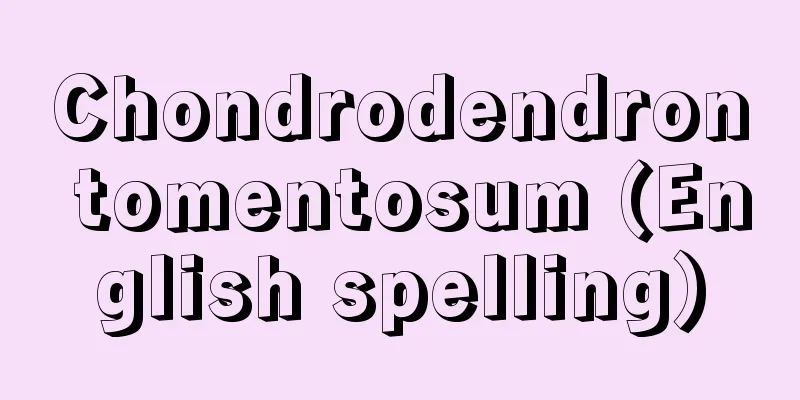The University of Tokyo

|
A national university corporation. Founded on April 12, 1877 (Meiji 10). Its origins date back to the Bansho Shirabesho (Institute for the Investigation of Foreign Documents) (later changed to Kaiseisho) established by the Edo Shogunate in 1856 (Ansei 3) and the Vaccination Institute (later changed to the Western Medicine Institute and Medical Institute) established in 1858 by Western medicine doctors living in Edo. After the Meiji Restoration, both schools were restored by the new government, and in 1869, Kaisei School and Medical School were integrated under Daigaku (Main) Campus (the restored Shoheizaka Gakumonsho). In December of the same year, when Daigaku (Main) Campus was renamed University, the two schools were renamed Daigaku Nanko and Daigaku Toko. However, due to the conflict between the Japanese, Chinese and Western schools, Daigaku was abolished, and the two schools were simply called Nanko and Toko, and developed as Western studies educational institutions directly under the new government. The South Campus subsequently became the First University District First Middle School, Kaisei School, and Tokyo Kaisei School, while the East Campus became the First University District Medical School and Tokyo Medical School, before merging to form the University of Tokyo in 1877. Part of the Hongo grounds was originally the main residence of the Kanazawa Maeda clan of Kaga, and the Red Gate, which was built in 1827 (Bunsei 10) when the 11th shogun, Tokugawa Ienari, married Princess Yohime, is the only one still standing. It has been designated an Important Cultural Property of Japan and has become synonymous with the University of Tokyo. [Minoru Nakano] EstablishedAt the time of its establishment, the university was made up of four faculties: Law, Science, Letters, and Medicine, and also managed the Tokyo University Preparatory School (the predecessor to the First Higher School). As of 1881 (Meiji 14), the university had 36 faculty members (including 16 foreign teachers) and 370 students. At the time, the University of Tokyo's expenses accounted for nearly 40% of the expenses managed by the Ministry of Education. The three faculties of Law, Science, and Letters were separated into Kanda Nishiki-cho, and the Faculty of Medicine was separated into Hongo Motofuji-cho, and they were only gathered on the Hongo campus after the establishment of the Imperial University. After this nascent period, the University of Tokyo became an Imperial University in 1886 with the promulgation of the Imperial University Act, and was established by incorporating specialized educational institutions under the jurisdiction of other government ministries, such as the School of Law (Ministry of Justice) and the College of Engineering (Ministry of Engineering). As the only university in Japan, it stood at the pinnacle of the school system and strengthened its character as a national institution. The Imperial University was organized into five separate colleges (Law, Medicine, Engineering, Literature, and Science) and one graduate school, with a three-year course of study (four years for Medicine). Following the founding of Kyoto Imperial University in 1897, various university organizations were established during the period leading up to the change of name to Tokyo Imperial University. First, the name of the President was adopted as the university's leader, the Council was established as the university's highest decision-making body (1886), the lecture system was adopted (1893), the faculty council of the separate colleges was established (1893), and the honorary professor system was adopted (1893), forming a model for modern Japanese universities. At the same time as the Imperial University was established, the President also served as the president of the Law College, and was given the authority to supervise the educational curriculum of the five major private law schools in Tokyo Prefecture (currently Senshu University, Meiji University, Waseda University, Chuo University, and Hosei University). In addition, the Civil Service Examination Probationary and Apprenticeship Regulations (1887) gave Imperial University graduates the privilege of virtually being appointed without examination. In 1890, the University of Agriculture (formerly the Tokyo Agricultural and Forestry School, under the jurisdiction of the Ministry of Agriculture and Commerce) was established. [Minoru Nakano] Tokyo Imperial University eraThe 50 years from 1897 (Meiji 30) to 1947 (Showa 22) constituted the era of Tokyo Imperial University. Until the middle of the Taisho period, there were no major changes in the system or reality, but the university continued to expand in size. Affiliated research institutes such as the Institute for Infectious Diseases (1916) and the Research Institute for Aeronautics (1921) were established, and the university's forests expanded to former colonies (Taiwan, Korea, and Karafuto). In 1918 (Taisho 7), the University Act was promulgated, legally recognizing the establishment of public and private universities other than the Imperial University. In addition, the specialized college system was changed to a faculty system, and a comprehensive university system based on faculties was adopted. Various reforms were also implemented at Tokyo Imperial University during this period. (1) The academic year began in April (previously September), (2) Honor students and scholarship students were abolished, (3) Graduation ceremonies were abolished (but were reinstated in 1928), (4) A mandatory retirement age for professors and assistant professors (60 years old), and (5) Elections for candidates for president and deans were implemented one after another. The number of faculties and research institutes was also increased, with the Faculty of Economics (1919) and the Second Faculty of Engineering (closed in 1942 and 1951), and the attached research institutes included the Tokyo Astronomical Observatory, the Earthquake Research Institute, the Institute of Oriental Culture, which was the only humanities research institute at Tokyo Imperial University before World War II, the Southern Natural Science Institute (renamed the Natural Science Institute in 1946 and abolished in 1952), and the Institute of Radiation Chemistry (abolished in 1950). Including those that were reorganized or abolished after the war, there were seven attached research institutes by the time of Japan's defeat in 1945. Also during this period, the Great Auditorium (commonly known as Yasuda Auditorium) was completed (1925), and the Faculty of Agriculture was relocated from Komaba, Meguro Ward to Yayoi-cho, Hongo (exchanging land with the former First Higher School in 1935). [Minoru Nakano] Regarding university autonomy and freedomStarting with the Tomizu Incident in 1905 (Meiji 38), the University of Tokyo experienced many incidents regarding university autonomy and academic freedom from the Taisho to prewar Showa periods. These included the Morito Incident (1920), the Yanaihara Incident (1937), the Professor Group Incident (1938), and the university reform issue involving the election of the president, professors, and assistant professors by the Minister of Education, Araki Sadao. In particular, the Hiraga Purge, in which President Hiraga Yuzuru proposed suspending the Faculty of Economics professors Kawai Eijiro and Hijikata Narumi in 1938 (Showa 13), shocked the public. In 1941, the faculty general rules were revised, and the admissions oath that had been suspended since the Taisho period was reinstated, and the submission of student certificates signed by family contacts was required. University-wide lectures, special defense corps, and all-university academic societies were organized, and the wartime system of the University of Tokyo was established. [Minoru Nakano] New University of TokyoImmediately after Japan's defeat in World War II, difficult issues arose, including requisition by the Allied forces, accommodation for faculty and students, and the reinstatement and removal from public office of professors, while the dismantling of the wartime system progressed. Among these problems, the admission of female students in 1946 (Showa 21) was a bright spot, as it was the first time since the university's founding. In 1947, Tokyo Imperial University became the University of Tokyo (old system), and new research institutes such as the Institute of Social Science and the Institute of Newspaper Studies (now the Graduate School of Interdisciplinary Information Studies) were established. In 1949, the National School Establishment Act was promulgated, and the new University of Tokyo was launched. The new University of Tokyo incorporated the former First Higher School and the former Tokyo Higher School, and established the Faculty of Liberal Arts and the Faculty of Education, with nine faculties and ten affiliated research institutes. In 1958, the Faculty of Pharmacy was established. In 1968, a dispute arose over the issue of medical trainees, which led to the cancellation of the 1969 entrance examination. The university celebrated its 100th anniversary in 1977. In 1981, the Institute of Space and Astronautical Science, an attached research institute, and in 1988, Tokyo Astronomical Observatory, were transferred to the Ministry of Education (now the Ministry of Education, Culture, Sports, Science and Technology), and became the Institute of Space and Astronautical Science and the National Astronomical Observatory, respectively. In 1996, the University Museum of the University of Tokyo was opened. [Minoru Nakano] Current StatusAs of 2010, the University of Tokyo has 10 faculties, 13 graduate schools, 2 graduate education departments, 2 graduate research departments, 11 affiliated research institutes, numerous educational and research facilities attached to them, and 3 facilities for national joint use. There are 14,128 undergraduate students, 13,894 graduate students, and 570 research students, totaling 28,592 students (as of May 2011). Of these, 241 are foreign students at the undergraduate level, 2,299 at the graduate level, and 361 at the research level. The number of undergraduate graduates under the old system was 91,453, and the number under the new system was 153,978 (as of March 2006), totaling 245,431. In April 2004, following the enforcement of the National University Corporation Law, the university became a national university corporation. The headquarters is located at 7-3-1 Hongo, Bunkyo-ku, Tokyo. [Minoru Nakano] "The Fifty Year History of Tokyo Imperial University, volumes 1 and 2 (1932)" ▽ "The Centennial Editorial Committee of the University of Tokyo ed., Photograph Collection: One Hundred Years of Tokyo University 1877-1977 (1977, University of Tokyo Press)" ▽ "The Establishment of the University Autonomy System in Japan, by Terasaki Masao (1979, Hyoronsha)" ▽ "The Centennial History of Tokyo University, ed., The Centennial Editorial Committee of the University of Tokyo ed., The Centennial History of Tokyo University, all 10 volumes (1984-1987, University of Tokyo Press)" ▽ "The Birth of the Imperial University, by Nakayama Shigeru (Chuko Shinsho)" [References] | | | | | | | | | | |One of the predecessors of the University of Tokyo. It was renamed Kaisei School in April 1873 (Meiji 6) from the First University District First Middle School of the University South School. In October of the same year, a new two-story Western-style wooden school building was completed in Kanda Nishikicho, and a grand ceremony was held in attendance of the Emperor. Utagawa Kuniteru (II) painting "The Opening Ceremony of Kaisei School in the First University District of Tokyo" triptych, owned by the National Diet Library "> Kaisei School The current location of the University of Tokyo. Hon-Fuji-cho, Hongo-ku (currently Hongo, Bunkyo-ku, Tokyo). "Famous Places in Japan" (1900, Meiji 33) National Diet Library Tokyo Imperial University "Photo Collection of Scenic Places and Historic Sites of Japan, Based on National Elementary School Textbooks" (1912, held at the National Diet Library ) Akamon (Meiji period) Source: Shogakukan Encyclopedia Nipponica About Encyclopedia Nipponica Information | Legend |
|
国立大学法人。1877年(明治10)4月12日創立。その起源は、1856年(安政3)江戸幕府設立の蕃書調所(ばんしょしらべしょ)(洋書調所、開成所と変遷)と江戸在住の蘭方(らんぽう)医師たちにより1858年に設けられた種痘所(西洋医学所、医学所と変遷)にまでさかのぼる。明治維新後、両校は新政府により復興され、1869年大学(本)校(昌平坂(しょうへいざか)学問所を再興)のもとに開成学校、医学校が統合された。同年12月、大学(本)校が大学と改称したのに伴い、大学南校、大学東校と改称した。しかし、大学が国・漢・洋学派の抗争で廃止された結果、両校は単に南校、東校と称し、新政府の直轄洋学教育機関として発展する。その後、南校は第一大学区第一番中学、開成学校、東京開成学校、他方東校は第一大学区医学校、東京医学校と変遷し、1877年東京大学として合併された。 本郷の敷地の一部はもと加賀金沢前田家の上屋敷であり、1827年(文政10)に11代将軍徳川家斉(いえなり)の女(むすめ)溶姫が輿入(こしい)れする際に造営された赤門は現存する唯一のもので、国の重要文化財に指定されると同時に、東京大学の代名詞的存在になっている。 [中野 実] 成立発足当時の学部構成は法学、理学、文学、医学の4学部からなり、ほかに東京大学予備門(第一高等学校の前身)を所管していた。1881年(明治14)時点の教員数は36人(うち外国人教師16人)、学生数は370人であった。当時、東大経費は、文部省所管経費中の40%近くを占めていた。なお法学、理学、文学3学部は神田錦(にしき)町、医学部は本郷本富士町に分散し、本郷キャンパスに集結するのは帝国大学成立後である。こうした揺籃(ようらん)期を経て、1886年公布の帝国大学令により東京大学は帝国大学となり、他官省所管の法学校(司法省)、工部大学校(工部省)といった専門教育機関を包摂して成立し、日本唯一の大学として学校体系の頂点にたつとともに、国家機関的性格を強めた。 帝国大学は法科、医科、工科、文科、理科の五つの分科大学と一つの大学院から組織され、修業年限は3年(医科は4年)である。1897年京都帝国大学の創設に伴い、東京帝国大学と改称するまでの期間に大学諸組織の設置をみていた。まず、大学の統括者として総長名の採用、大学の実質的な最高意思決定機関としての評議会の設置(1886)、講座制の採用(1893)、分科大学教授会の設置(1893)、名誉教授制の採用(1893)など、近代日本における大学の範型を形成していった。帝国大学発足と同時に、総長は法科大学長を兼任し、あわせて東京府下の五大私立法律学校(現、専修大学、明治大学、早稲田(わせだ)大学、中央大学、法政大学)の教育課程を監督する権限を与えられた。また、文官試験試補及見習規則(1887)により帝国大学卒業生は事実上無試験任用の特典が付与された。1890年には農科大学(旧、東京農林学校・農商務省所管)を設置した。 [中野 実] 東京帝国大学時代1897年(明治30)から1947年(昭和22)までの50年間、東京帝国大学時代となる。大正なかばまで制度および実態上に大きな変化はみられず、その規模を拡大していった。伝染病研究所(1916)、航空研究所(1921)などの附置研究所が誕生し、演習林も旧植民地等(台湾、朝鮮、樺太(からふと))へ拡大していった。 1918年(大正7)大学令が公布され、帝大以外に官公私立大学の設置が法認された。また分科大学制が学部制に改められ、学部を構成原理とする総合大学制が採用された。東京帝国大学においてもこの時期さまざまの改革が行われた。(1)4月学年開始(従前9月)、(2)優等生・特待生の廃止、(3)卒業式の廃止(ただし1928年復活)、(4)教授・助教授の定年制(60歳)、(5)総長・学部長候補者の選挙などが逐次実施されていった。学部・研究所の増設も行われ、学部では経済学部(1919)、ついで第二工学部(1942年、1951年閉学)があり、附置研究所では東京天文台、地震研究所をはじめ、第二次世界大戦前東京帝大唯一の人文系の研究所として東洋文化研究所、戦争末期に至り南方自然科学研究所(1946年立地自然科学研究所と改称、1952年廃止)、輻射(ふくしゃ)線化学研究所(1950年廃止)が設けられた。戦後改組・廃止されたものを含めて、1945年の敗戦までに七つの附置研究所があった。また、この時期、大講堂(通称安田講堂)の竣工(しゅんこう)(1925)、農学部の目黒区駒場(こまば)から本郷弥生(やよい)町への移転(1935年、旧制第一高等学校との敷地交換)などがあった。 [中野 実] 大学の自治・自由をめぐって東京大学は1905年(明治38)の戸水(とみず)事件をはじめ、大正から昭和戦前期にかけて、大学の自治、学問の自由をめぐる諸事件に数多く遭遇した。森戸事件(1920)、矢内原事件(1937)、教授グループ事件(1938)、荒木貞夫(さだお)文相による総長・教授・助教授の選挙問題を含む大学改革問題などがあげられ、とくに1938年(昭和13)平賀譲(ひらがゆずる)総長が経済学部教授河合栄治郎・土方成美(ひじかたなるみ)の休職処分を上申した、いわゆる平賀粛学は世間の耳目を驚かせた。1941年、学部通則の改正が行われ、大正期以降中止されていた入学者宣誓の復活、家庭連絡者連署の在学証書の提出をはじめとして、全学講義、特設防護団、全学会などが組織され、東京帝大の戦時体制が成立した。 [中野 実] 新制東京大学第二次世界大戦の敗戦直後から連合国軍による接収問題、教職員・学生の宿舎問題、教授の復帰と公職追放などの難問が生じるとともに、戦時体制の払拭(ふっしょく)が進行した。そのなかでも、1946年(昭和21)の女子学生の入学は創立以来のことで、明るいニュースであった。1947年東京帝国大学は東京大学(旧制)となり、社会科学研究所、新聞研究所(現、大学院情報学環)など新しい研究所が設置された。1949年には国立学校設置法が公布、新制東京大学が発足する。新制東京大学は旧制第一高等学校、旧制東京高等学校を包摂し、教養学部、教育学部を設置、9学部、10附置研究所で出発した。1958年には薬学部が設けられた。1968年医学部研修医問題に端を発した紛争が起こり、それにより1969年度の入学試験が中止された。1977年創立100年を迎えた。1981年附置研の宇宙航空研究所、1988年東京天文台が文部省(現、文部科学省)に移管され、それぞれ宇宙科学研究所、国立天文台となった。1996年(平成8)東京大学総合研究博物館を開設。 [中野 実] 現況2010年(平成22)時点で、東京大学には10学部、13大学院研究科、2大学院教育部、2大学院研究部、11附置研究所と、それらに附属する多数の教育研究施設等および3全国共同利用施設がある。学部学生1万4128人、大学院学生1万3894人、研究生等570人、合わせて在学生総数2万8592人(2011年5月時点)となっている。そのうち外国人学生は学部241人、大学院2299人、研究生等361人である。学部卒業生は旧制9万1453人、新制15万3978人(2006年3月)、総計24万5431人に上る。2004年4月、国立大学法人法の施行に伴い、国立大学法人となる。本部は東京都文京区本郷7-3-1。 [中野 実] 『東京帝国大学編・刊『東京帝国大学五十年史』上下(1932)』▽『東京大学の百年編集委員会編『写真集 東京大学の百年 1877―1977』(1977・東京大学出版会)』▽『寺崎昌男著『日本における大学自治制度の成立』(1979・評論社)』▽『東京大学百年史編集委員会編『東京大学百年史』全10巻(1984~1987・東京大学出版会)』▽『中山茂著『帝国大学の誕生』(中公新書)』 [参照項目] | | | | | | | | | | |東京大学の前身の一つ。大学南校の第一大学区第一番中学から、1873年(明治6)4月に開成学校と改称された。同年10月には神田錦町に擬洋風木造2階建ての新校舎が落成、天皇を迎えて盛大な式典が催された。歌川国輝(2世)画『東京第一大学区開成学校開業式之図』 三枚続国立国会図書館所蔵"> 開成学校 現在の東京大学所在地。本郷区本富士町(現在の東京都文京区本郷)。『日本之名勝』(1900年〈明治33〉)国立国会図書館所蔵"> 東京帝国大学 『日本名勝旧蹟産業写真集 国定小学校教科書準拠 天』(1912年〈明治45〉)国立国会図書館所蔵"> 赤門(明治時代) 出典 小学館 日本大百科全書(ニッポニカ)日本大百科全書(ニッポニカ)について 情報 | 凡例 |
Recommend
Local Public Servants Act - Chiho Koumuinho
This is a general and fundamental law that applie...
Craft education - Craft education
It originated from handicrafts, which was added t...
Toyoha mine
This mine was located in the Jozankei area of M...
Itsuse no Mikoto
A god who appears in the Kojiki and Nihon Shoki. H...
Xun-xian ancient tomb - Xun-xian gu-mu
A Western Zhou period tomb in Xincun, Jun County, ...
Abeno Doji - Abeno Doji
...Abe no Doji, Seimei's childhood name, mean...
Church of Agios Georgios - Agios Georgios Church
… [Shoji Kiyonaga] [art] Within the city are the ...
VOR - Video Arrow
VHF omni-directional radio range is a ground radi...
Ryosenho - Ryosenho
In ancient Japan, laws stipulated marriages betwee...
Anasen - Anasen
…Danish author. In Danish, he is called Annasen. ...
Wilcoxon rank sum test
...Statistical inference that does not assume a s...
Perfect form - Perfect form
… The term aspect is originally used to describe ...
Salad - Sarada (English spelling) salad English
It is a cold dish consisting of raw vegetables, b...
Yawata Steel Works
Formerly Japan's largest steel company. In the...
Luminescence - Luminescence
A luminous phenomenon in which a substance releas...









